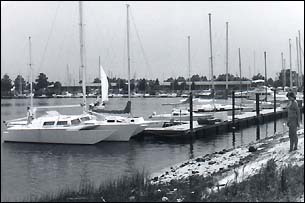
Shell Point sailboat harbor in 1976. The motel roof can be seen between tree tops.
Shell Point
by
Frank Howard and
Susan H. Sapronetti
September 4, 1993
 (1) Fiber tempered; (2) Complicated Stamp design; (3) Large Check Stamp design. Click image for larger view. |
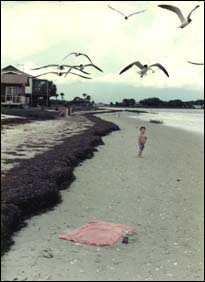 Strolling down the east end of Shell Point beach in 1977. The trees of Live Oak Island are across the canal. |
While archaeologists tell us there were established Stone-age inhabitants in the area one must recall Shell Point was well inland and dry at that time. Perhaps the first people to regularly use Shell Point as waterfront were of the Fiber-Tempered Culture (some 2000 or more years B. C.). A number of fiber-tempered potsherds have been found along the beach as it washes from the old dredge spoil. Other such shards have been found along the beach in front of the Restaurant and on both Gull and Live Oak Islands. The "shells" of Shell Point have been collecting for a long time as people have gone out to the oyster bars to bring back those delicacies for their lunch and then leave the leftovers on the shore (4000 years later and we still haven't learned to do better; drink can and plastic bag mentioned above).
Swift Creek Culture potsherds have also been found on the beach and at several building sites back from the beach. This culture (500 B. C. ~ 500 AD) produced heavily decorated Complicated- Stamped pottery. The potsherds remaining from these early beach users generally show deeply stamped curving designs which sometimes include portions that are stamped over another part of the design. If one is finding small potsherds along the beach these will certainly be the ones that elicit the "Hey, look at this one!" as the deep smooth-flowing curves are very artistic. You would be holding a beautiful reminder that many people have lived on, worked on, and enjoyed this little stretch of beach long before our New World history begins.
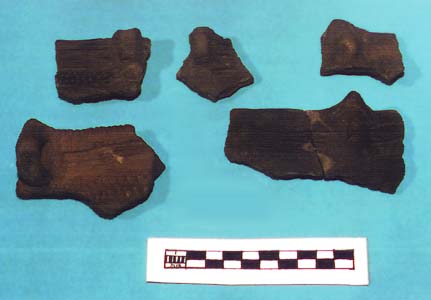 The above photo is of Weeden Island Indian pottery pieces which contain knobs or pot handles. Click image for larger view. |
In among the potsherds one kicks over on the beach are those from the Weeden Island Culture (500 AD ~ 1100 AD). These may be plentiful but are least often collected by the beach walking tourist. Some of the pottery from this culture, with its delicately incised carvings and artistic pot shapes, is the most exquisite one can find in any museum. But so many of the shards found along the beach are either too small to show this or, more likely, come from their utility ware pottery. The utility ware pottery (the daily user pots of this and other later cultures) are for the most part undecorated and very plain. Even the experts have to go to the microscope to differentiate these small plain shards. One lady from Georgia was observed recovering an unusually large (3 inches) but well eroded effigy-head potsherd with its distinctly Weeden Island incised decoration still visible. She was elated even though she had been walking the outwash along the beach high tide line looking for "fossil shark teeth!"
By far the most commonly - carried - home shard types are those from the Fort Walton Culture (1100 AD ~ 1550 AD). Even the small shards can show the check-stamped and linear roll - stamped decorations of this culture. The stampings (small diamond or square shapes very close together) are shallow when compared to those of the Swift Creek Culture but are so well defined they have lasted into our time as very clear and distinctive patterns.
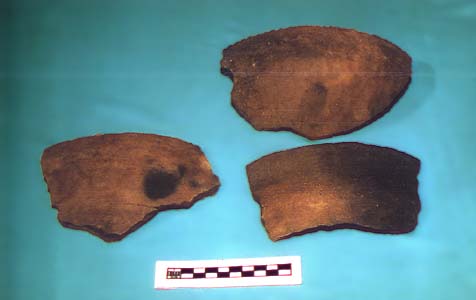 The three potsherds shown above are from the Fort Walton Culture (1100-1550 AD). Click photo for larger view. |
The mounds which did exist both on Shell Point and in its vicinity come from this Ft. Walton culture. Many of the shell middens associated with these mounds now form the foundations for our houses. This is the culture that preceded the Apalachees (or should it include them as the last of the culture?) . The Apalachees were the people living in the area at the time of European contact. Recall the European Contact period began right next door and most certainly affected this area immediately.
There are still places back away from the beach which contain the evidence needed to sort out our picture of who these people were. We know all too little about this part of our past and our zeal to build is bulldozing away so much before it can be studied. For instance, Spanish records indicate a small village of Tocopaca Indians living in this general area but does not tell us exactly where. Perhaps some house builder will spot the locale as land is cleared to build and get the professionals in to help before the site is dug away. In Oyster Bay Estates, an area stocked with pottery - making materials sufficient for a very large pottery making outfit was found which seems to date to pre-contact times but too much of the site was lost to get a complete story. At least now we know that one existed there!
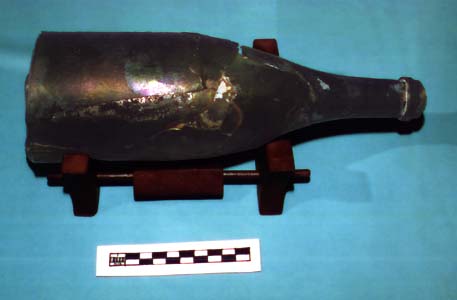 The glass bottle shown above was found on Hobie Beach at Shell Point. Click on image for larger view. |
The European Contact period is also represented by "beach artifacts" as a goodly number of English, French, and Spanish wine bottle shards have been found on the beach. Even whole bottles! Just to the east of the Coast Guard Aux. house, a few years back, one of several Hobie Cats was being launched when the popping sound of a breaking glass bottle came from beneath a tire. The sailor had thrown only the jagged thick bottom far out into the channel when he was stopped by a young lady who had recognized the ancient, almost black, glass bottle. She recovered the bottle less its bottom and remarked she has several other bottle - bottoms and bottle parts that have been collected from the beach. Spanish olive jar and Indian made copy ware shards have also been found on the beach.
A commonly asked question concerns the presence of pieces of clay bricks along the beach. Did someone have a brick house or business there? Were they bought in as fill or something? All along the coast during the Civil War there were saltworks. This includes the hastily constructed canvas-over-pine poles sun powered evaporators up to the very sophisticated huge iron kettle brick furnace company owned evaporators (with steam powered pumps to pump the seawater!). Apparently there were salt works at Shell Point. There were Confederate Troops stationed at Shell Point. Shell Point was considered by both sides to be one of the only two possible invasion points. Shell Point and St. Marks both had roads over which troops could be moved. On hand-drawn (War Intelligence?) maps dated 1861-65 the Shell Point Fishery and the road to it are clearly labeled along with the distances to each key point on the coast.
There are folks around who can remember riding on a "corduroy road." In the days of wagons and the early automobiles, surfaced roads were few. The marshy areas of the coast did not hold up well as roads. So, green pine pole were cut, bark-stripped, and laid down across the roadway tightly against each other. The soil thrown on top of them did not stay put very long and they soon looked, and worse - rode, like corduroy cloth. The remnants of one of these roads can be seen at low tide where the canal has cut through it at Oyster Bay. There was a time when one to Shell Point could still be found.
After the Civil War the fishing business returned to Shell Point. Those fishing businesses existed right on down to modern times. The seine yard compared in size to the many others of the county. In the early 1900's the yard was operated by Mr. Bob Raker. There was an old supply house near the Indian mound which was used as a camp base by townsfolk who came down to observe and participate in the seine netting process (not to mention feasting on grits, hoecakes, and the absolutely fresh mullet!). There were racks nearby on which the large nets were hung for drying, inspection, and repairs. As the road to Shell Point was passable only at the lower tides, these campground type visits were frequently overnight.
Mr. B. B. Stevens will tell you there is no telling how old the seine yard was ("..maybe a hundred years...") when he began managing it for the Taff family in 1926. This writer's first visit there was in about 1940 or '41. The beach was perhaps the only place around where small kids could be rowed out a few hundred yards offshore and safely put out in knee-deep water. For the few hours around low tide they could find hundreds of little sea creatures to view along with enough scallops to add a child's delight to the evening chowder.
While it seems only yesterday, in truth, it was more than twenty years ago that the last of the small guide boat and for-day-hire boat fleet disappeared from the newly dredged yacht basin as it quickly filled up with the explosion of sailboats coming into the area. Then came the Apalachee Bay Yacht Club with its early versions of sailboat racing. To the beach came the day sailors, the Hobie Cats, and finally, the wind surfers. The beach has gotten smaller, but it is still fun to sit there and watch the kids, er, ah, the grand kids play in the shallow water while watching the wind surfers zoom by over the flats.
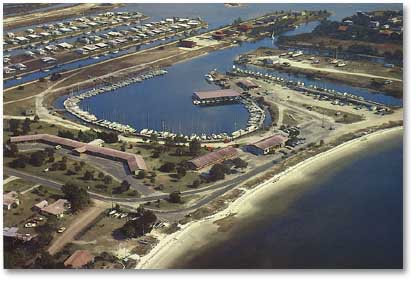
|
|
View of Shell Point taken from the air in 1979. |
Follow these links for additional information on Native American pottery:
- The Collector's Guide to Pueblo Pottery Terms
- Learn about the Black-on-Black, Coiling, and more. This site also contains an excellent list of related links.
- Native American & Pre-Columbian Artifacts
- This is a commercial site where artifacts are available for purchase. However, in addition to excellent photos of artifacts, you will also find articles on collecting artifacts, Native American history by time period, as well as an excellent list of links.
- Native Web Arch
- Resources for indigenous cultures around the world.
- Amerind Foundation, Inc.
- The Amerind Foundation Museum and Archaeological Research Facility has a list of publications which may be of interest.
